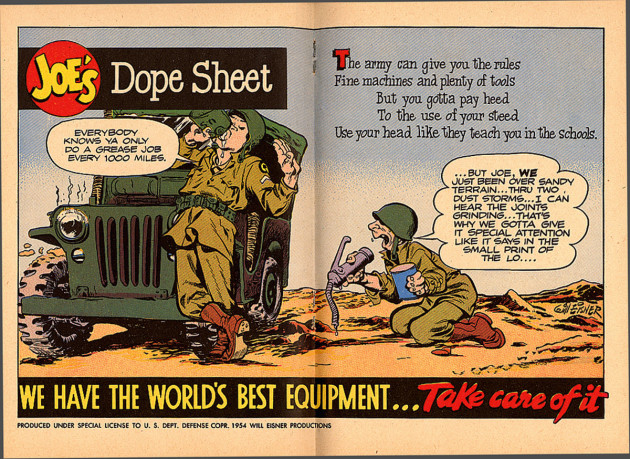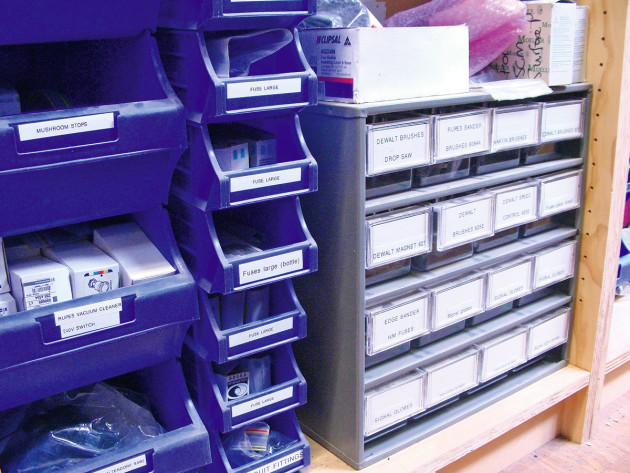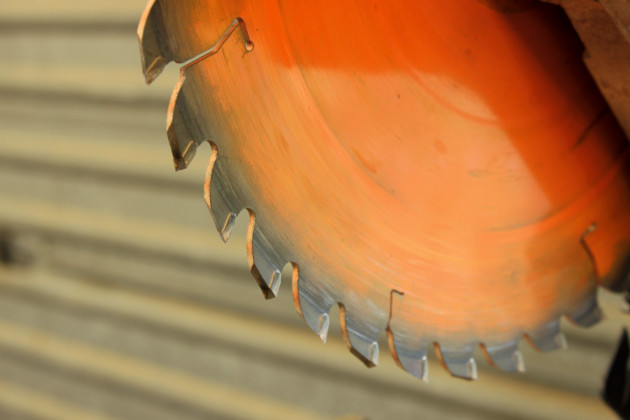The US Army has published a monthly comic-book style magazine since 1951. The Army Magazine of Preventive Maintenance uses humour to make GI’s aware of the benefits of maintenance and the dangers of ignoring it via characters like private Joe Dope and sergeant Macon Sparx. One issue notes: ‘A slipping gear in your M203 grenade launcher can cause it to fire when you least expect it. This could make you very unpopular with what is left of your unit.’ Maintenance is a major issue whether you use military equipment, manufacture helicopters or make fine furniture.

A key to any successful manufacturing process is the ongoing performance of your equipment. If you own woodworking machinery you will be concerned with its maintenance sooner or later. The ‘sooner’ is your planned or preventative maintenance. The ‘later’ is your emergency or reactive maintenance, or repair. Whether you are a small manufacturer or have a home workshop, it is accepted that repairing breakdowns will cost four times more than preventative maintenance, so it pays to think ahead. A preventative (or proactive) maintenance plan will not only save you money and time, but will extend the life of your expensive equipment. Your machinery will always be ready when you are.

Preventative maintenance (we’ll refer to this as PM from now on) is your action plan designed to prevent your machines breaking down. PM is designed to maintain the reliability of your equipment by prolonging the life of existing machine parts and replacing worn parts before they fail. Tasks include regular equipment checks, adjustments to machine elements, replacement of worn parts, oil changes, lubrication, its use within manufacturer’s recommendations and general housekeeping. Your plan will also involve recording your maintenance so you will have a good idea which parts of your equipment are likely to fail and hopefully, when. If your maintenance plan is a success, you should be able to prevent all equipment failure before it happens. Ideally the cost of your PM should be lower than corrective or reactive maintenance.
The cost of PM is regarded in engineering circles as being four times less than corrective maintenance. This figure does not take into account lost production and loss of good-will when your order is delivered late. A typical machine breakdown scenario would see several minutes lost as you discover the machine is not working properly, 30 minutes to identify the problem, at least an hour to get replacement parts if they are available locally and at least 30 minutes to make even a minor repair. All this is happening when it is least convenient. Your PM plan would ensure that the machine was working properly and worn parts replaced well before they fail. Your downtime now would be the time to install the part, usually at a convenient moment.
Your action plan
As all of your machines are different, you will need a PM schedule for each of them. This will detail what needs to be maintained, how it’s to be maintained and when the maintenance is done. In a business this will be signed and dated but for your workshop it should at least be dated.

One important action should be a pre-start safety check. This is now common in trade schools and business and ensures that before a machine is started, a check is made on the adjustments and condition of the machine. This check will identify simple faults that can be fixed ‘on-the-fly’. This is done on a daily, weekly or monthly basis, depending on the machine. For instance, I recommend that the cutterguard and front table of the surface planing machine be checked for proper operation every day it is used. The same applies with the riving knife and top guard of the circular saw and the tracking and guides of the bandsaw. Spindle moulder fences and thicknessing machines can be checked on a weekly basis if you use the workshop every day. You can set your own schedule according to your needs.
You can also have a list of safety precautions and rules displayed at the machine, especially if the equipment is used by other people and you want to have some control over what is happening in your own shop.
Your inventory
In order for your PM to work you will need a small inventory of parts. It’s a good idea to talk to your machine supplier and ask what machine parts you should keep on hand. A spare set of drive belts for each machine is essential, as are the correct lubricants. A range of nuts, bolts and screws will come in handy and I strongly suggest investing in some spare cutter bolts and other frequently adjusted parts.
Keeping spare bearings is a good idea if you can change them yourself; otherwise get to know a local repairer. So as not to lose any of your kit, a stores list with all the parts, part numbers, supplier details and what the part is for, should also make your maintenance a little easier. You will also need some tools and maintenance ‘stuff’ that includes oil and grease. You will need a good set of spanners and sockets, screwdrivers and both metric and imperial allen keys to do the work. To complete your kit, get hold of a good straight-edge, a caliper, a very good square, dial indicator and a set of feeler gauges.
A small maintenance cupboard is ideal to keep your PM supplied with all the items you need to keep your machinery running in peak condition. Every machine should come with a manual stating the recommended lubricants and service intervals. With some imported machinery, the recommended lubricant may not be available. You may find that if you observe all the manufacturer’s recommendations you will have a cupboard full of them. Try to reduce this by finding out what type of lubricant is required, not which brand and you may be able to survive with very few lubricants. You don’t want to keep too much on hand as it can deteriorate over time, in some cases after only a year.

If you can, get grease guns with a clear cylinder, or clearly mark the contents. That way you reduce the risk of congealing two different (mixed) greases. If you cannot locate the manufacturer’s recommendations for lubricant, try Caltex or Shell as both supply a range of industrial lubricants with excellent information on the internet. It’s a very good idea to copy this information and hang it on your machine. That way you will never forget about it. A log book is highly recommended as it stores a history of your machine; what parts it has consumed and how often it has been serviced. This log will be a bonus if you sell the machine as the buyer will appreciate what you have done to maintain it in top condition.

Look and listen
Many potential problems can be detected early. Drive belts should be inspected regularly for wear. 
Nuts and bolts can be inspected for rounding-over. Watch the floor for oil leaks and check the condition of electrical cables regularly.

You should also have your leads checked by a competent ‘test and tag’ person, especially if you are in business. Listen to your machine for a few minutes, just to see if it sounds right as bearing failure can often be predicted. There’s an old trick of putting the tip of a screwdriver on the bearing housing and the handle against your ear. It’s not as accurate as a $700 vibration monitor or mechanic’s stethoscope, but it works. Your ears will also tell you when the cutters need changing or the drive belts need tightening. As most of your equipment is designed to cut wood, keeping the tools sharp is one of the most important activities in your PM plan. Blunt tools increase the load on the motor and strain your drive belts.

Stay clean
In the life of any machine, cleanliness is king. The contamination of moving parts such as bearings and gears with a build-up of dust or shavings can lead to costly repairs. Dust will eventually clog slide-ways and most adjustable machine parts such as chains and gears. Rather than removing dust after it has been created, extract it during machining with a good dust extractor and a potential breakdown can be avoided. Avoid blowing the dust away with an airgun as this may force the dust between the machine parts, causing even more damage. If you need to remove old, hardened lubricants from your machinery, a nylon or brass brush in conjunction with an environmentally-friendly citrus-based solvent will usually be enough.

The adjustment of your machine parts should also not be ignored as poorly adjusted parts can lead to fatigue and premature wear. Riving knives on circular saws; guides on bandsaw machines; rollers and pressures on panel planers should all be adjusted and checked regularly for proper operation. Have you ever looked at the tyres on your bandsaw to see if they are cracked or have lost their flexibility? The cost for ignoring this is reduced blade life and potentially increased bearing wear. Does your bandsaw have a wheel brush? This simple addition will help to eliminate dust and chips getting onto the rubber wheel and causing premature wheel deterioration or bearing failure through increased vibration.

Frequency
Even if you think the machine hasn’t been used for a while it’s a good idea to service it on a date basis—that way you won’t forget to look after it. Australian Standard AS1473-1991, Section 5 deals with maintenance of industrial machinery and states ‘each entire machine is to be inspected by a competent person at least once every six months or at any lesser interval recommended by the manufacturer’. While the Standard is aimed at industry it is still a good yard-stick, and for the home workshop every 12 months is reasonable for a good PM program. When you consider that the Erikson S-64 (Elvis) helicopter requires two hours service for every hour of flight, 12 months for a woodworking machine is not much to ask.
Easy on the grease
It’s worth a moment to think about over-greasing. Too much can be as bad as too little. Excess grease can be forced from over-packed bearings on older machinery and become a ‘fly-trap’ for dust and woodchips. In addition, it is common practice to apply grease until it extrudes from the bearing and on low speed equipment this is not a problem. On high-speed woodworking equipment however, excess grease at high speed can be forced from the bearing, loosening seals and actually breaking parts of the bearing resulting in high temperatures and premature bearing failure. On newer equipment bearings are usually ‘sealed-for-life’ and require no greasing at all.
Benjamin Franklin is quoted as saying ‘An ounce of prevention is worth a pound of cure’. This means it is better to avoid problems in the first place, rather than fixing them once they occur. Your workshop may be full of expensive equipment but even if you only have one machine, the benefits of preventative maintenance cannot be ignored. Gains in machine efficiency, lifespan, safety, reduced downtime, lower repair costs and that warm feeling you get when you know your workshop is in top condition are all factors that are affected by a good preventative maintenance system. You would not risk missing a service on your car so why would you do the same with your woodworking machinery? It actually costs surprisingly little to set up—you probably have most of what you need already and the benefits could be quite significant.
This story first appeared in Australian Wood Review magazine, issue 70.














